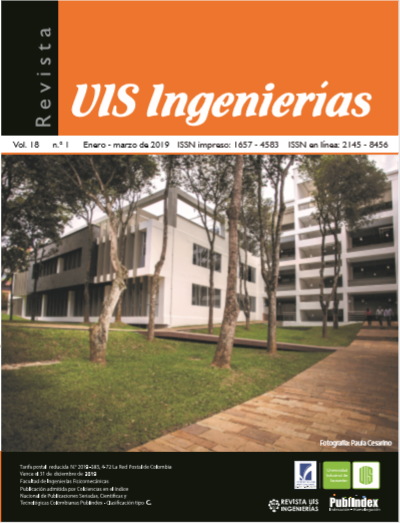Articles
Application of a linear elastic model to the study of crack stability in concrete dams
Published 2019-01-01
Keywords
- finite element method,
- stress intensity factor,
- concrete gravity dams,
- seismic analysis
How to Cite
Braun, M., Zappitelli, M. P., Villa, E. I., & Rocco, C. (2019). Application of a linear elastic model to the study of crack stability in concrete dams. Revista UIS Ingenierías, 18(1), 203–212. https://doi.org/10.18273/revuin.v18n1-2019018
Abstract
In this paper, the results of a numerical analysis to obtain the stress intensity factor in mixed mode, KI and KII, in a cracked concrete dam submitted to seismic loads are presented. The numerical model was implemented in the commercial finite element code Abaqus/Standard. Koyna dam geometry was used, including a crack parallel to the horizontal plane. In order to evaluate the importance of guaranteeing an adequate crack sealing using epoxy resin, a second parametric study was done considering partial crack sealing. The study results allow determining the cracks that endangered the dam structural integrity under seismic loads.
Downloads
Download data is not yet available.
References
A.M. Fathy Abdelaziz, “Inyección de grandes grietas con resina epoxi”, Tesis Doctoral, Universidad Politécnica de Madrid, 1996.
ACI Committee 224, “Control of Cracking in Concrete Structures,” American Concrete Institute, ACI 224R-01, 2002.
O.C. Guedelhoefer and A.T. Krauklis, “To bond or not to bond,” Concrete International: Design & Construction, Detroit, USA: 1986, pp. 10-15.
P.D. Krauss, J.M. Scanlon and M.A. Hanson, “Evaluation of Injection Materials for the Repair of Deep Cracks in Concrete Structures,” US Army Corps of Engenieers, Washington D. C., USA, REMR-CS-48, Aug, 1995.
D. Higgins, “Repairs to cracks in concrete,” The Concrete Society, vol. 17, no. 2, pp. 26-28, 1983.
R.T.L. Alien, “Choosing a concrete repair system,” Construction Repairs & Maintenance, vol. 2, no. 5, pp. 10-12, 1986.
E.I. Villa, M. Braun, M.P. Zappitelli, A. Vaquero Hernández y C.G. Rocco, “Simulación numérica del proceso de inyección de fisuras en presas de hormigón,” en Anales de Mecánica de la Fractura XXVIII, Gijón, 2011, pp. 625-630.
C.G. Rocco, M. Braun, M.P. Zappitelli, y E.I. Villa, “Estabilidad de fisuras en presas de hormigón frente a la acción de presiones internas”, Mecánica Computacional, vol. 30, pp.127-139, 2011.
Z. Bazant and J. Planas, Fracture and Size Effect in Concrete and Other Quasibrittle Materials. London: CRC Press, 1998.
A. K. Chopra y P. Chakrabarti, “The earthquake experience at koyna dam and stresses in concrete gravity dams,” Earthq. Eng. Struct. Dyn., vol. 1, no. 2, pp. 151–164, 1972. doi: 10.1002/eqe.4290010204
M. L. Ayari y V. E. Saouma, “A fracture mechanics based seismic analysis of concrete gravity dams using discrete cracks,” Eng. Fract. Mech., vol. 35, no. 1–3, pp. 587–598, 1990. doi: 10.1016/0013-7944(90)90233-7
P. E. Skrikerud y H. Bachmann, “Discrete crack modelling for dynamically loaded, unreinforced concrete structures,” Earthq. Eng. Struct. Dyn., vol. 14, no. 2, pp. 297–315, 1986. doi: 10.1002/eqe.4290140209
ABAQUS, “User’s Manual Version 6.13”. Karlsson and Sorensen Inc, 2014.
N. Toshio y D. M. Parks, “Determination of elastic T-stress along three-dimensional crack fronts using an interaction integral,” Int. J. Solids Struct., vol. 29, no. 13, pp. 1597–1611, 1992. doi: 10.1016/0020-7683(92)90011-H
T. L. Anderson y T. L. Anderson, Fracture Mechanics: Fundamentals and Applications, Third Edition. Taylor & Francis, 2005.
F. Erdogan y G. C. Sih, “On the Crack Extension in Plates Under Plane Loading and Transverse Shear,” J. Basic Eng., vol. 85, no. 4, p. 519, 1963. doi: 10.1115/1.3656897
ACI Committee 224, “Control of Cracking in Concrete Structures,” American Concrete Institute, ACI 224R-01, 2002.
O.C. Guedelhoefer and A.T. Krauklis, “To bond or not to bond,” Concrete International: Design & Construction, Detroit, USA: 1986, pp. 10-15.
P.D. Krauss, J.M. Scanlon and M.A. Hanson, “Evaluation of Injection Materials for the Repair of Deep Cracks in Concrete Structures,” US Army Corps of Engenieers, Washington D. C., USA, REMR-CS-48, Aug, 1995.
D. Higgins, “Repairs to cracks in concrete,” The Concrete Society, vol. 17, no. 2, pp. 26-28, 1983.
R.T.L. Alien, “Choosing a concrete repair system,” Construction Repairs & Maintenance, vol. 2, no. 5, pp. 10-12, 1986.
E.I. Villa, M. Braun, M.P. Zappitelli, A. Vaquero Hernández y C.G. Rocco, “Simulación numérica del proceso de inyección de fisuras en presas de hormigón,” en Anales de Mecánica de la Fractura XXVIII, Gijón, 2011, pp. 625-630.
C.G. Rocco, M. Braun, M.P. Zappitelli, y E.I. Villa, “Estabilidad de fisuras en presas de hormigón frente a la acción de presiones internas”, Mecánica Computacional, vol. 30, pp.127-139, 2011.
Z. Bazant and J. Planas, Fracture and Size Effect in Concrete and Other Quasibrittle Materials. London: CRC Press, 1998.
A. K. Chopra y P. Chakrabarti, “The earthquake experience at koyna dam and stresses in concrete gravity dams,” Earthq. Eng. Struct. Dyn., vol. 1, no. 2, pp. 151–164, 1972. doi: 10.1002/eqe.4290010204
M. L. Ayari y V. E. Saouma, “A fracture mechanics based seismic analysis of concrete gravity dams using discrete cracks,” Eng. Fract. Mech., vol. 35, no. 1–3, pp. 587–598, 1990. doi: 10.1016/0013-7944(90)90233-7
P. E. Skrikerud y H. Bachmann, “Discrete crack modelling for dynamically loaded, unreinforced concrete structures,” Earthq. Eng. Struct. Dyn., vol. 14, no. 2, pp. 297–315, 1986. doi: 10.1002/eqe.4290140209
ABAQUS, “User’s Manual Version 6.13”. Karlsson and Sorensen Inc, 2014.
N. Toshio y D. M. Parks, “Determination of elastic T-stress along three-dimensional crack fronts using an interaction integral,” Int. J. Solids Struct., vol. 29, no. 13, pp. 1597–1611, 1992. doi: 10.1016/0020-7683(92)90011-H
T. L. Anderson y T. L. Anderson, Fracture Mechanics: Fundamentals and Applications, Third Edition. Taylor & Francis, 2005.
F. Erdogan y G. C. Sih, “On the Crack Extension in Plates Under Plane Loading and Transverse Shear,” J. Basic Eng., vol. 85, no. 4, p. 519, 1963. doi: 10.1115/1.3656897

